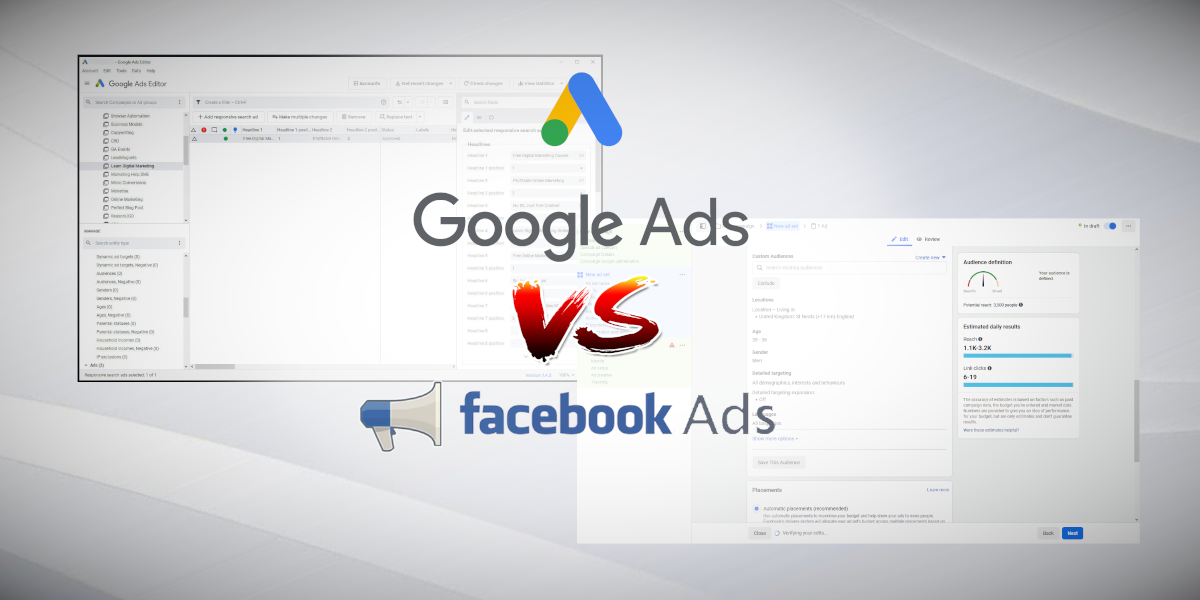The two largest ad networks in the world go head to head in this article. Google Ads vs Facebook Ads provides an overview of the differences between the ad networks with the aim of deciding where to allocate advertising budget for your business. At the end of this article you can find the links to in depth guides on the technical aspects of running performance marketing campaigns on each of these ad networks.
- Facebook And Google Advertising
- Differences Between Google Ads And Facebook Ads
- Campaign Targeting Options Compared
- Facebook And Google Ads Cost
- Allocating Advertising Budget Examples
- Which Is Better Facebook Ads or Google Ads
- Facebook & Google Performance Marketing Guide Links
Facebook And Google Advertising

This article is focused on Google’s search advertising also known as Pay Per Click (PPC). The Google Ads network extends far beyond Google search however. Google owns Youtube which is the largest publish for video ads. They also run Adsense which allows website owners to earn revenues through banner ad placement. Advertisers have access to this entire inventory of 3rd party websites and mobile applications.
Facebook Ads in contrast provides display advertising placements on Facebook and other group and audience network properties such as Instagram. The data that Facebook has from users interaction with the social network allows advertisers to segment an audience by interest and behavioral targeting methods.
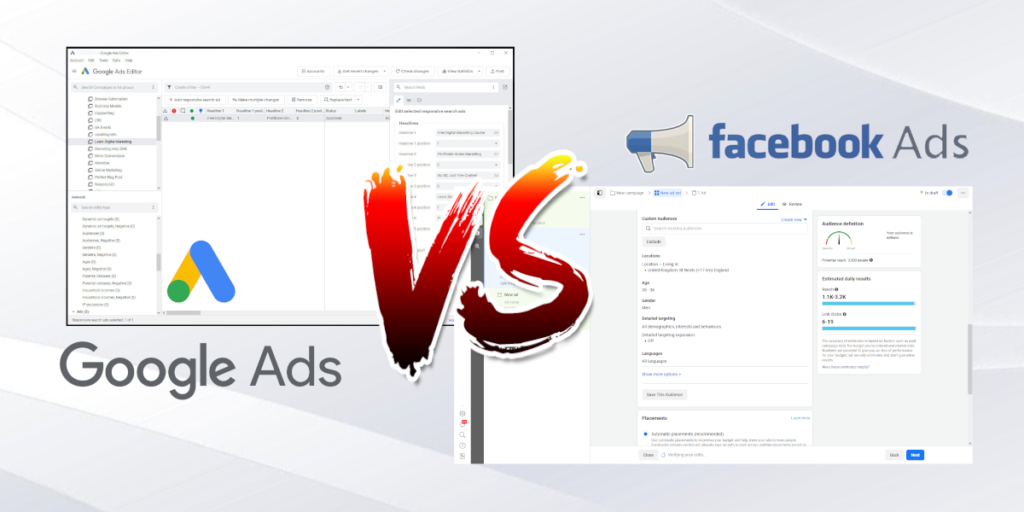
Differences Between Google Ads And Facebook Ads
The key difference between search (Google) and display (Facebook) ads is that display ads are a form of disruptive marketing. With search advertising someone needs to be searching for your product or service or at least terms related to that niche. With display advertising you can target a specific demographic and introduce a new product or service that they may not be aware of.
This is particularly important for tech startups that are working on niche products. If there isn’t already a strong demand for the product and people aren’t Googling for a solution that this product solves then it may be difficult to gain initial traction and customer acquisition.
With PPC ads advertisers will provide a list of keywords which will be matched to search queries. The end users is shown a display ad like this
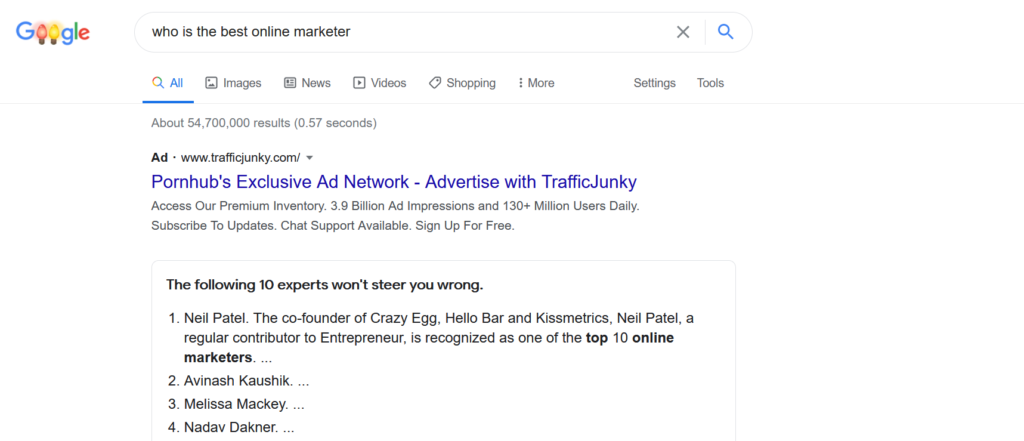
On Facebook advertisers will provide text, images and often video content which will be put into a display creative like below. Notice the main ad for Google then there are two other ads in the top right.
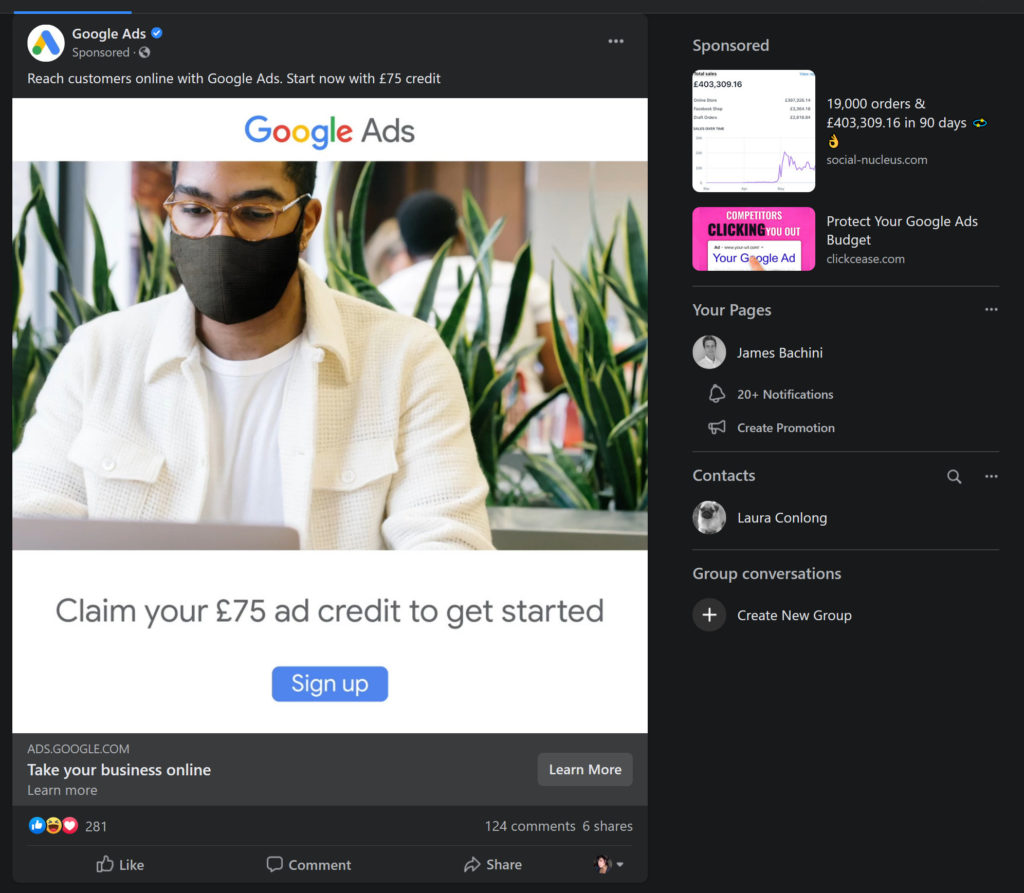
The vast majority of Facebook’s traffic is mobile in-app on Facebook and Instagram. This will open up the destination URL in the internal browser in most cases. Google has more desktop traffic and arguably a more engaged user base. This can be important when promoting B2B products where advertisers want to engage a client when in work mode on their laptop.
Campaign Targeting Options Compared
Facebook lead the way with advanced targeting options and revolutionized the digital advertising sector. Still their targeting is more advanced than anything else available although Google and other ad networks are playing catch up.
Facebook’s advertising is more granular. Taking age demographic targeting for example we can target by the precise age to the year on Facebook where as on Google we are somewhat limited to age ranges such as 19-29 etc.
Both networks offer retargeting campaigns meaning advertisers can segment previous customers or visitors to their website and run ads specifically to those users. With Google this is more applicable to their display network however rather than Search Ads.
Both networks offer clearly defined region targeting. You can target local areas by a search radius or urban regions specifically. This is essential for local businesses or companies looking for customers nearby.
Facebook’s lookalike audience targeting is more advanced however Google is great too which allows advertisers to scale out campaigns based on conversion data.
When targeting Google PPC campaigns advertisers tend to focus more on search intent and delivering on expectations for the visitor. Targeting on Facebook is more focused around interest based targeting and what interest associations potential clients would have.

One thing to note is that when setting up campaigns in Google and Facebook Ads the default options are not good at all for the advertiser. They are set to generate as much revenue for the ad network not deliver campaign performance for the advertiser. Check the links at the bottom of this article for more in-depth advertising guides on how to setup campaigns.
Facebook And Google Ads Cost
Ad costs vary based on the following:-
- Geographic region
- Audience segmentation (demographic, interest etc)
- Niche / Sector
- Time of year
- Device targeting (device, browser, network etc.)
- Placement
For this reason it’s impossible to say one is cheaper than the other. That being said there are some generalisations that are true across most industries.
Return on Ad Spend (ROAS) tends to be higher on more targeted campaigns. When search queries are based on purchase intent then nothing beats Google Search Ads for delivering engaged customers.
The advanced targeting options on Facebook do however make it possible to niche down very finely limiting volume but delivering highly relevant and interested visitors.
Facebook is a form of disruptive advertising so the landing page needs to capture interest and provide a compelling reason to take action right at that moment. A limited time offer or a “delivery tomorrow if you order in the next x mins” type offer might work well. People are online because they want to look at family pics and cat videos not engage with your brand.
In contrast search ads generally deliver people who are actively searching for a solution or product. They may not all be willing to pay for it but they are at least searching for it and in either research or buying mode.
As a general reference Facebook Ad costs right now in December for US traffic will back out at around $10 CPM. In summer it was closer to $5 CPM partly due to economic slowdown and just because there’s not as many brand advertisers that time of the year. CPM is Cost per Mille or cost per one thousand impressions.
Google ads varies so much based on the niche. In a non-competitive niche in tier 3 countries you can get clicks as low as $0.01 per visitor. In US for highly competitive finance related keywords you can be bidding over $100 per visitor. Google provides a keyword planner which will give you a better idea of keywords in the industry you are working in.
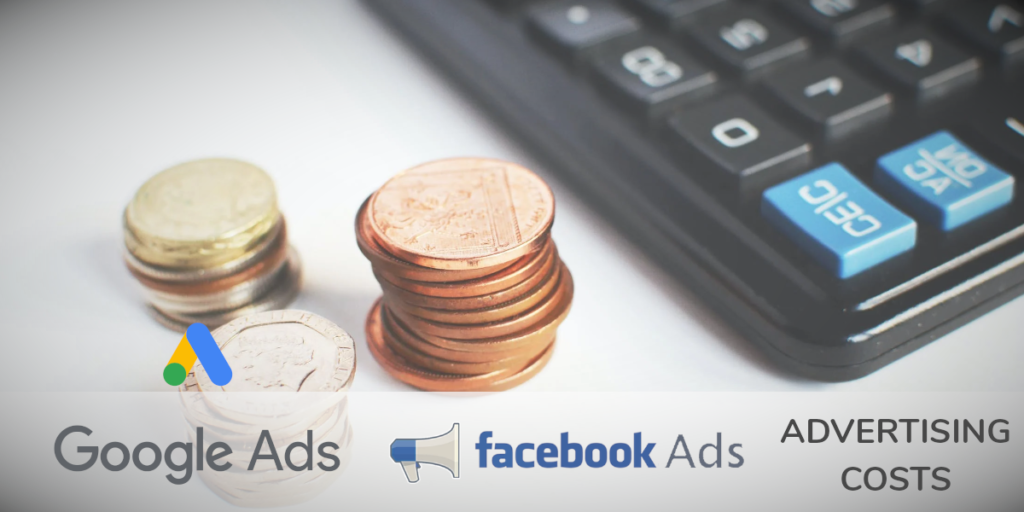
This will give you an idea of the cost per view or click but that might not help with calculations for cost per new customer. For this the best way to find out is to run a small test and use conversion rate optimization CRO to continually improve this metric. By improving the conversion rate between click and customer you can outbid competitors and new market entrants in the long-term.
Allocating Advertising Budget Examples
Budgets should be based on performance. Daily budgets can be setup on both ad networks which can be used to setup small tests. Try highly targeted small volume tests to give you some data to work with. Then allocate budget based on which network is delivering the best return on ad spend.
You’ll need conversion tracking setup to measure the effectiveness of your campaigns. More info on that here: https://jamesbachini.com/analytics-strategy/
Here are some very general budget allocations based on what I’ve seen work for different companies in the past.
Local Bricks & Mortar Business (SME’s)
- 30% on Facebook Ads locally targeted > direct response campaign (Get performance data & revenues, don’t rely on likes)
- 20% Google Search Ads (Often limited by volume rather than performance quality)
- 10% Retargeting Ads
- 40% on Website, Hosting, Design, Content, SEO (These costs can take up a higher percentage of the budget for smaller companies. Regular content is really important for long-term brand building.
Lookalike campaigns can work really well with local businesses that target a specific demographic. If your business has similar customers then it’s worth exploring.
SaaS Startup – New Product (Audience Unaware)
- 30% Google Search Ads (Industry Related Terms) > PDF Guides – Lead Capture Content Marketing > Sales Funnel
- 20% Retargeting Display Advertising on Google Ads Network
- 10% Video Discovery Ads
- 30% Facebook/Instagram Content Feed Ads Video Demo > Free Trial
- 20% Facebook Ads Retargeting Campaigns
There’s a whole article on SaaS Marketing Strategy here.
Digital Product – eBook / Course
- 70% Google Ads > direct to sales page (digital products should address a core problem that people are searching for a solution to so it most of the budget goes here)
- 10% Retargeting Display Advertising on Google Ads Network
- 10% Facebook Ads Retargeting Campaigns
- 10% Test Budgets for everything else (affiliates, clickbank, joint ventures, growth hacking etc)
Brand Advertisers – Large Enterprises
- 50% Facebook Ads
- 20% Google Search Ads
- 20% Google Display/Video Ads
- 5% Retargeting Display Advertising on Google Ads Network
- 5% Facebook Ads Retargeting Campaigns
Brand advertisers tend to spend more on social traffic because it provides a bigger opportunity to tell their story and develop brand awareness.
Which Is Better Facebook Ads or Google Ads
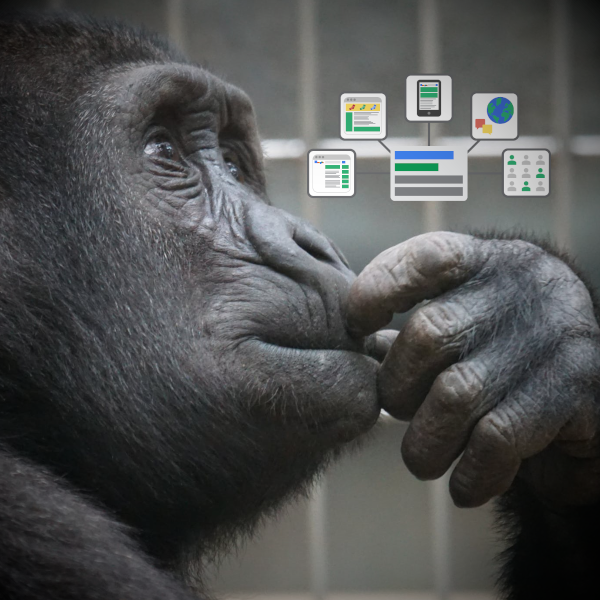
If people are searching for your products and services or Googling for solutions to a problem that your product solves then start with Google Ads. The keyword planner I mentioned lets you check search volumes and costs to see how viable this is.
If your product is new or people don’t know about it yet or there just isn’t a lot of search traffic then disruptive advertising is the next avenue to test. Facebook ads is leader in this space and their campaign targeting is incredible. There has never been a more powerful advertising tool in the history of marketing.
If you want to know what will work best for your business then test some campaigns with small daily budgets, collect the data and scale up the best performing ads.
Facebook & Google Performance Marketing Guide Links
If you are interested in learning more about online marketing then check out the free digital marketing course.
This includes an in-depth guide on running performance marketing campaigns for both Facebook Ads and Google Ads.
✅ If you’ve enjoyed these resources could you help share this content on social media and send it to anyone who you think might benefit. It helps me out a lot!
Thank you.


